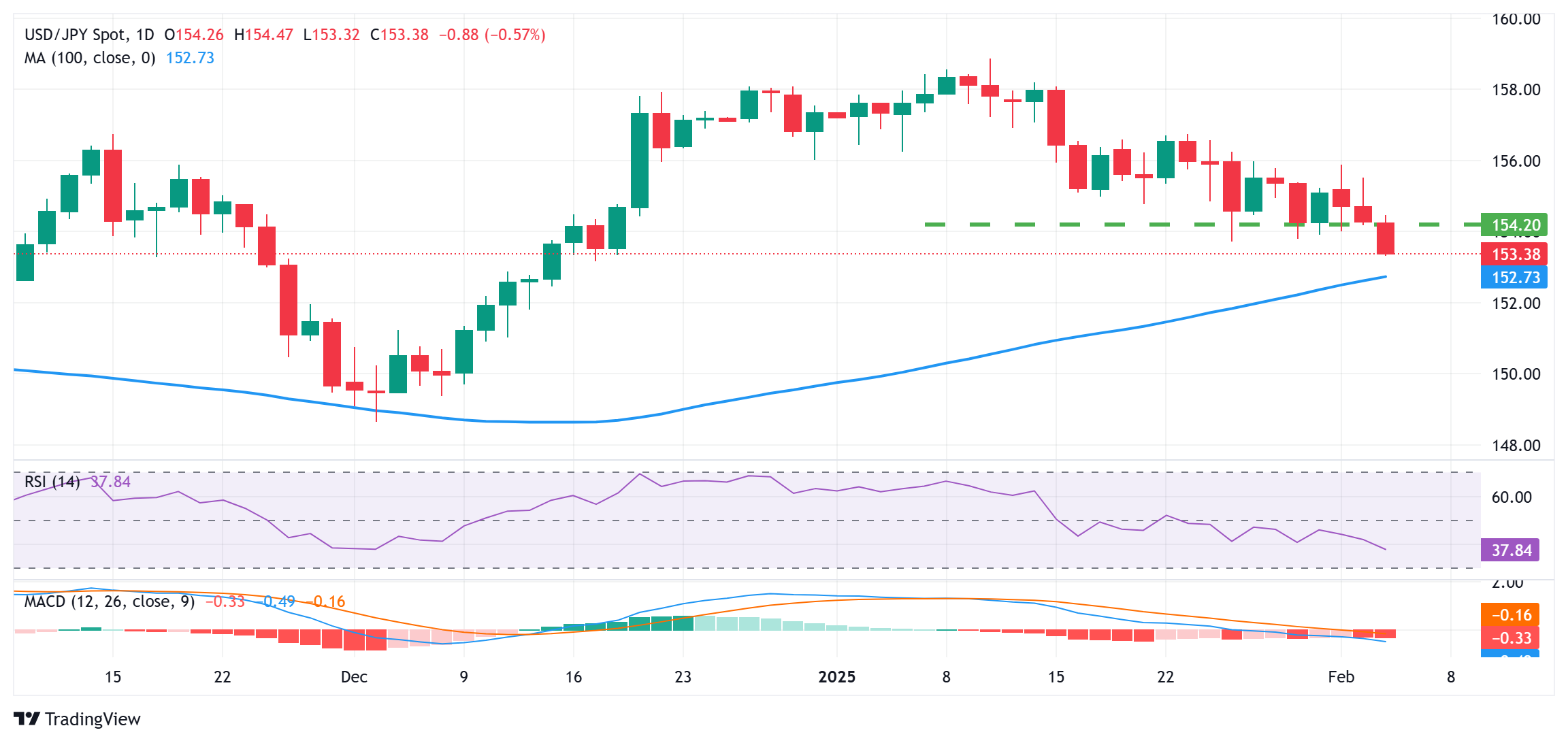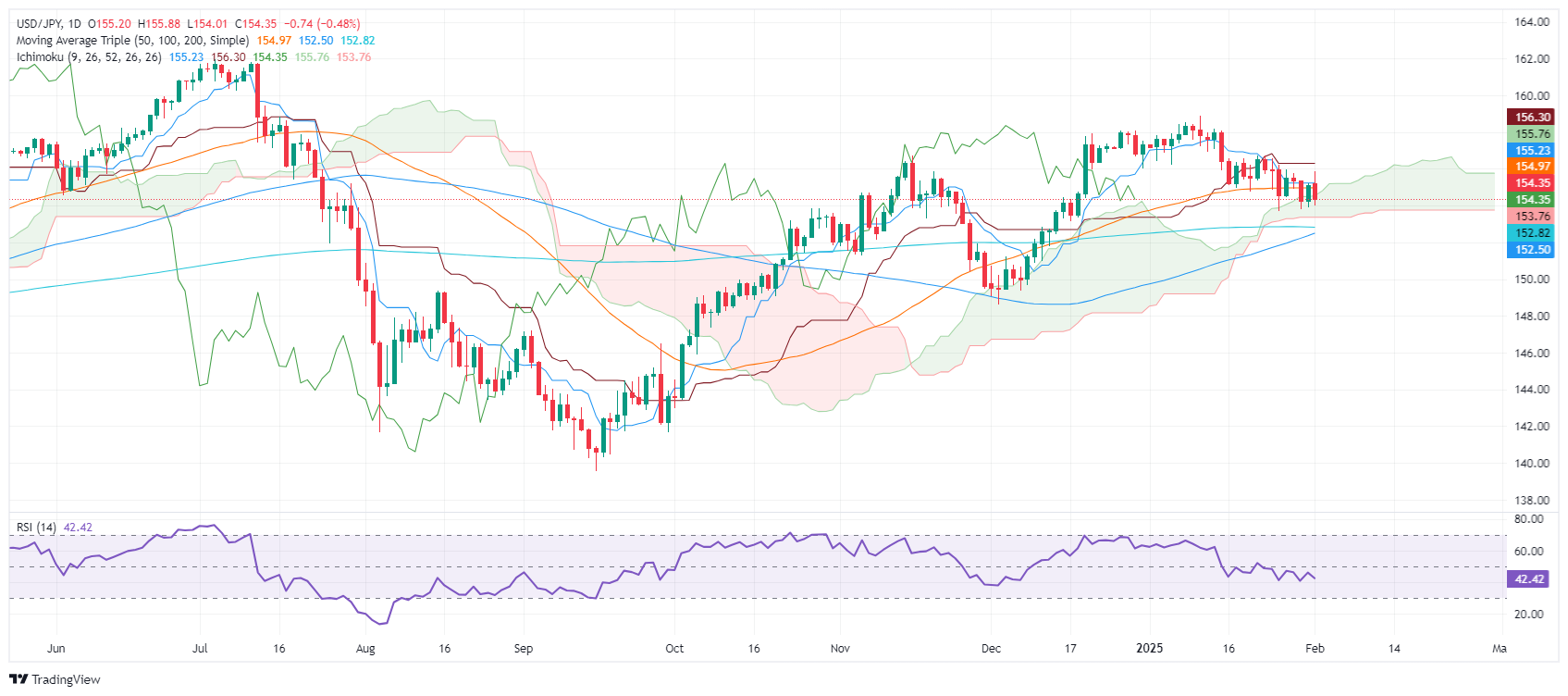- Analytics
- News and Tools
- Quotes
- Chart and quotes for USDJPY
CFD Trading Rate US Dollar vs Japanese Yen (USDJPY)
| Date | Rate | Change |
|---|
Related news
-
05.02.2025 10:25USD/JPY: USD is likely to trade in a range – UOB Group
US Dollar (USD) is under mild downward pressure; it could edge lower, but any decline is unlikely to break below 153.70. In the longer run, for the time being, USD is likely to trade in a 153.70/156.70 range, UOB Group's FX analysts Quek Ser Leang and Peter Chia note.
USD is under mild downward pressure
24-HOUR VIEW: "Following Monday’s choppy price action, we indicated yesterday that USD 'could continue to trade in an erratic manner, probably in a range of 154.50/156.00.' We did not expect USD to drop to a low of 154.16, closing at 154.33 (-0.27%). The decline has resulted in a slight increase in downward momentum. Today, we expect USD to edge lower, but given the mild downward momentum, any decline is unlikely to break below the major support at 153.70. On the upside, a breach of 155.00 (minor resistance is at 154.70) would suggest that the mild downward pressure has faded."
1-3 WEEKS VIEW: "There is not much to our update from yesterday (04 Feb, spot at 155.20). As indicated, USD 'is likely to trade in a 153.70/156.70 range for the time being.' Looking ahead, if USD were to break and remain below 153.70, it could trigger a sustained drop."
-
05.02.2025 02:20Japanese Yen rallies on strong wage growth data; USD/JPY slumps to mid-153.00s
-
04.02.2025 22:04USD/JPY Price Analysis: Retreats below 155.00 on trade war tensions
-
04.02.2025 14:41USD/JPY jumps above 155.00 as demand for safe-haven assets diminish
-
04.02.2025 10:24USD/JPY: To trade in an erratic manner – UOB Group
-
03.02.2025 15:24USD/JPY pulls back as trade tensions stir market uncertainty
-
03.02.2025 13:21USD/JPY: Bias for USD is tilted to the upside – UOB Group
-
31.01.2025 11:09USD/JPY: BoJ's Ueda notes more hikes in the pipeline – BBH
-
30.01.2025 15:16USD/JPY falls as US GDP misses estimates bolstering Yen
-
30.01.2025 13:49A break below 153.35 for USD/JPY is going to be a bearish signal – Rabobank
-
30.01.2025 10:37USD/JPY Price Forecast: Japanese Yen strengthens as BoJ hawkish bets swell
-
29.01.2025 19:31USD/JPY stays steady as Fed holds rates, turns mildly hawkish
-
29.01.2025 14:37USD/JPY ticks lower despite US Dollar performs strongly ahead of Fed policy decision
-
29.01.2025 10:20USD/JPY is directionless above 155.00 – BBH
-
27.01.2025 14:23USD/JPY plummets to near 154.00 as Yen strengthens across the board
-
27.01.2025 10:26USD/JPY: Consolidation on the day – OCBC
-
24.01.2025 14:28USD/JPY rebounds to near 156.50 as BoJ refrains from committing specific rate hike path
-
24.01.2025 10:50USD/JPY: Risk of a deeper pullback is likely – Societe Generale
-
23.01.2025 15:27USD/JPY declines on soft US jobs data, eyes on Trump
-
23.01.2025 11:16USD/JPY edges lower to near 156.30 ahead of BoJ’s policy decision
© 2000-2025. All rights reserved.
This site is managed by Teletrade D.J. LLC 2351 LLC 2022 (Euro House, Richmond Hill Road, Kingstown, VC0100, St. Vincent and the Grenadines).
The information on this website is for informational purposes only and does not constitute any investment advice.
The company does not serve or provide services to customers who are residents of the US, Canada, Iran, The Democratic People's Republic of Korea, Yemen and FATF blacklisted countries.
Making transactions on financial markets with marginal financial instruments opens up wide possibilities and allows investors who are willing to take risks to earn high profits, carrying a potentially high risk of losses at the same time. Therefore you should responsibly approach the issue of choosing the appropriate investment strategy, taking the available resources into account, before starting trading.
Use of the information: full or partial use of materials from this website must always be referenced to TeleTrade as the source of information. Use of the materials on the Internet must be accompanied by a hyperlink to teletrade.org. Automatic import of materials and information from this website is prohibited.
Please contact our PR department if you have any questions or need assistance at pr@teletrade.global.






















